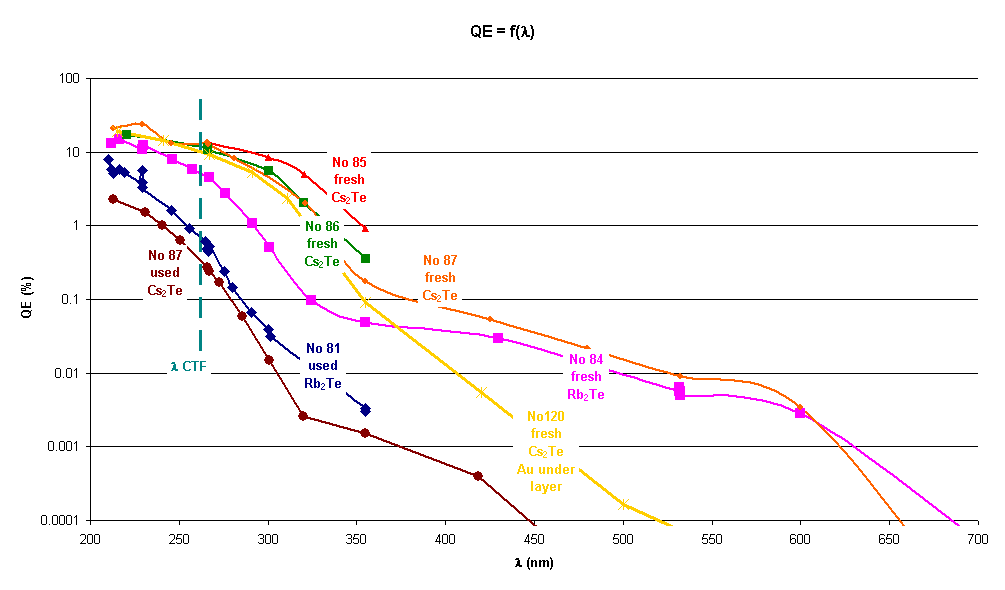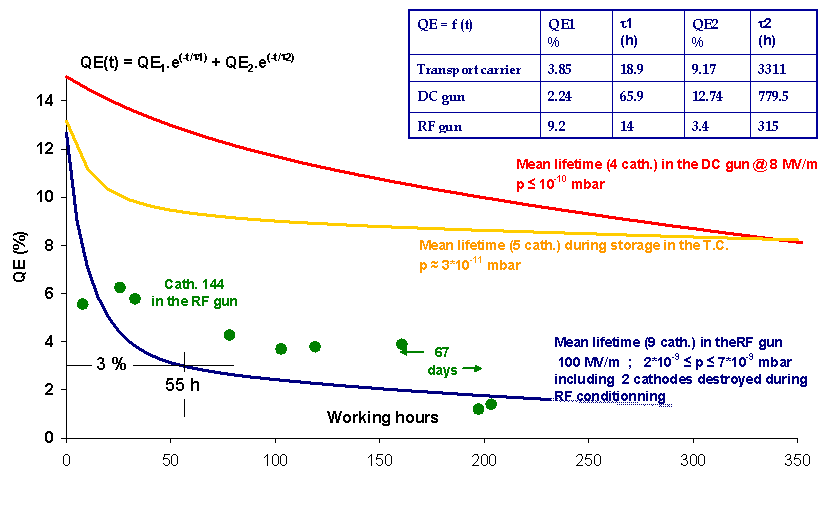In alkali photocathodes, electrons come from the valence level. For electrons to escape, photons must deliver enough energy to raise the electron from the valence to the conduction band (Eg)
and from conduction band to vacuum level (Ea), so to produce electrons the energy of photons must be: Ephotons > Eg + Ea for a single photon process.
we have tested and produced 3 different kinds of alkaline photocathodes:
|
Alkali-halide photocathodes | |
|
Alkali-antimonide photocathodes | |
| Alkali-telluride photocathodes |
|
Between December 1990 and October 1993 cesium iodide (CsI) photo-cathodes were used because they can be transported in air
[CLIC Note 162]
. Unfortunately, their photo-emission threshold is high (6.3 eV) involving the use of the fifth harmonic of a Nd:YLF laser (l=209
nm). This wavelength was found to be impractical, so the possibility of using photo-cathodes at the fourth harmonic (l=262
nm) were investigated. | |
|
A thin 2 nm coating of germanium over a CsI cathode decreases the QE at 213 nm by a factor of 10, but improves it at 262 nm from 7x10-5 to 0.13 %
[CLIC Note 203]
. This coating does not change the air exposure property of the CsI. To improve adhesion, a 200 nm layer of aluminum is deposited on the copper cathode plug before the 350 nm CsI layer, which is
then coated with 2 nm of Ge. These photo-cathodes are stored in a desiccator. Finally they are installed, in air, in the RF gun which is then baked to 150°C to improve the vacuum. These cathodes
require a delicate conditioning process using high electric fields and laser pulses to remove the oxidized surface without destroying the thin germanium layer. After 10 to 15 hours of processing,
the QE reaches up to 0.2 % with an electric field of 70 MV/m. The lifetime is quite long: the time constant
t
(the time to drop down to QEmax/e) is more than one year. | |
|
At high charge, both for CsI and CsI-Ge, we have experienced unexpected behavior in th RF gun: satellite bunches and saturation, so we have decided to carry out research on other alkali photocathodes. |
|
l
[nm] |
193 |
213 |
266 |
355 |
E
a+Eg |
|
E [eV] |
6.42 |
5.82 |
4.66 |
3.49 |
[eV] |
|
CsI |
9.6
*10-2 |
6.8*10-2 |
7.1*10-5 |
1.9
*10-6 |
6.4 |
|
CsI-Ge |
|
7.3
*10-3 |
1.3*
10-3 |
2.0
*10-6 |
5.0 |
We produced and tested alkali antimonide cathodes as described by A.H. Sommer in "Photoemissive Materials". In general we observed a good efficiency but cut-off wavelengths shorter than expected, and very short lifetimes. As expected the influence of the vacuum quality was observed, both on the QE and the lifetime of the cathodes.
|
l
[nm] |
213 |
266 |
355 |
532 |
E
a+Eg |
|
E [eV] |
5.82 |
4.66 |
3.49 |
2.33 |
[eV] |
|
Cs
3Sb |
3.5*
10-2 |
2.0*
10-2 |
1.8*
10-2 |
3.8*
10-3 |
2.0 |
|
K
3Sb |
1.4*
10-2 |
1.6*
10-2 |
7.6*
10-3 |
2.3*
10-4 |
2.3 |
|
Na
2KSb |
7.7*10
-2 |
6.1*
10-2 |
3.5*
10-2 |
2.0*
10-4 |
2.0 |
At the green light (532 nm) the QE was too low and the lifetime very short (from 1 to few hours). For this reason we decided to move to UV light and test more robust photocathodes.
Four kinds of alkali telluride photo-cathodes were produced and tested on different substrates: Cs2Te, K2Te, Rb2Te and RbCsTe. All require UV light ( l < 270 nm) for operation. For short, high-intensity electron bunches, alkali-tellurides have proved to be a reliable photo-cathode material.
|
l
[nm] |
213 |
266 |
355 |
532 |
E
a+Eg |
|
E [eV] |
5.82 |
4.66 |
3.49 |
2.33 |
[eV] |
|
Cs
2Te |
2.1
*10-1 |
1.3*
10-1 |
1.8*
10-3 |
9*
10-5 |
|
|
Rb
2Te |
1.3
*10-1 |
4.5*10-2 |
4.8*10-4 |
5.7* 10-5 |
|
|
K2Te |
1.6*
10-2 |
|
|||
|
RbCsTe |
7.7*10-2 |
|

The photocathode lifetime depends mainly of the preparation and the working conditions.
